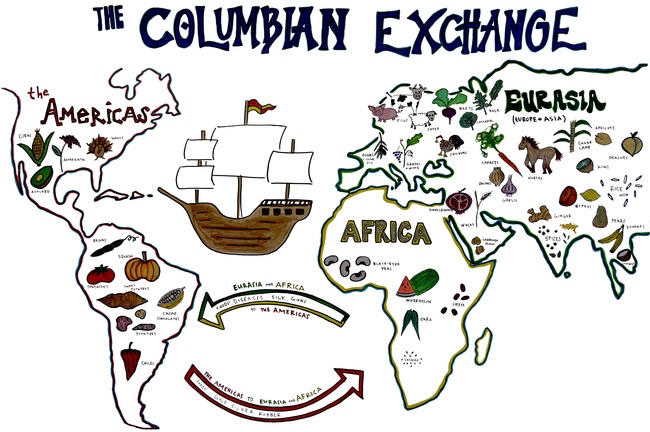Kitchen Humanities: Ghanaian Black-Eyed Peas

Summary
In this 7th grade humanities lesson, students prepare Ghanaian Black-Eyed Peas and examine the exchange of foods between Eurasia, Africa, and the Americas during the Columbian Exchange.
Objectives
After this lesson, students will be able to:
- Recognize the major economic and social effects of the Columbian Exchange on Eurasia, Africa, and the Americas
- Make connections between the diets of historic cultures and the foods we eat today
Assessments
During this lesson, students will:
- Discuss the exchanges of plants, animals, technology, culture, and ideas between Eurasia, Africa, and the Americas during the Columbian Exchange
- Realize that different plants and animals originate in different regions of the world
Materials
For the Chef Meeting
- Ghanaian Black-Eyed Peas recipe
- Ingredients and tools for demonstration
- Visual aid
Ingredients
- Spiced butter or butter
- Red onion
- Tomatoes
- Chili flakes
- Garlic
- Ginger
- Berbere or chili powder
- Coconut milk
- Turmeric
- Black-eyed peas
- Water
- Salt
- Cilantro
- Scallions
Optional Ingredients
- Potatoes
- Yams
- Collard greens
- Kale
- Chard
- Carrots
Tools
- Heavy bottomed pot
- Mixing bowls
- Wooden spoon
- Chef knives
- Paring knives
- Cutting boards
- Measuring beaker and/or measuring cups
- Measuring spoons
- Ladle
- Can opener
Equipment
- Stove
Before You Begin
- Create the visual aid
- Copy the Ghanaian Black-Eyed Peas recipe to hand out
- Copy the Spiced Butter recipe to hand out
- Copy the Berbere recipe to hand out
- Cook the black-eyed peas
- Prepare the Spiced Butter
- Prepare the Berbere
- Gather supplies for the Chef Meeting
- Collect all the tools and ingredients, and then distribute them to the tables
Procedures
At the Chef Meeting
- Introduce the Ghanaian Black-Eyed Peas and explain that before we begin cooking, we will trace the journey of the black-eyed pea from its origins in West Africa to the ESY kitchen classroom in the United States.
- Using the visual aid, have the students identify the three main landmasses involved in the Columbian Exchange. Review each of the empires, civilizations, or cultures that existed on each landmass before the Columbian Exchange:
- In the Americas, the Incan and Aztec empires were thriving. Recall the staple crops of the Aztec and Inca people, as well as other foods that originated in the Americas.
- In Africa, the kingdoms of Ghana, Songhai, and Mali had built cities and established major trade routes with Northern Africa and the Arabian Peninsula.
- Europe and Asia (Eurasia) were already trading via the Silk Road. Eurasia was also the only landmass with firearms.
- Emphasize that before the Columbian Exchange and the dawn of worldwide trade, foods and animals often associated with a particular region did not yet exist in that region (i.e., Native Americans did not ride horses, Ireland did not have potatoes, Italy did not have tomatoes, etc.).
- Address the impact of the Columbian Exchange and its effects on each of the three landmasses: Eurasia, the Americas, and Africa.
- Explain how, as the only people with guns, Europeans began to colonize the Americas and Africa. New crops brought to Eurasia from the Americas, such as corn and potatoes, became staple crops in Europe. Further, farming and mining in the Americas enabled Europe to establish a new and very lucrative economy.
- Reiterate that before the Columbian Exchange, the Americas had no domesticated animals. The Europeans brought cows, sheep, pigs, horses, and chickens. Domesticated animals are often carriers of diseases, and the Europeans brought smallpox, measles, and influenza to the Americas.
- Explain that the new diseases brought to the Americas killed up to 90% of the first Americans. Have all the students stand up and choose three students to remain standing while everybody else takes a seat. Ask the students to explain why only three people out of the thirty students remained standing.
- Discuss how the demand for money in Europe, coupled with widespread disease related deaths, created a labor shortage in the Americas. This led to the enslavement of West Africans by Europeans and the establishment of African slavery in the Americas.
- Revisit the origin of black-eyed peas and explain how black-eyed peas were carried over to the Americas in the hulls of slave ships. Discuss the cultural significance of the black-eyed peas and its importance in Southern cuisine.
- Using the visual aid, have the students identify the origin of the different ingredients in the Ghanaian Black-Eyed Peas recipe.
- Ask students to wash their hands and join their table group
At the Table
- Meet with the table groups to review the recipe and assign jobs.
- Prepare the recipe and set the table.
- Eat.
- Clean up.
At the Closing Circle
Using the visual aid, have students identify the origin of ingredients in their favorite foods.